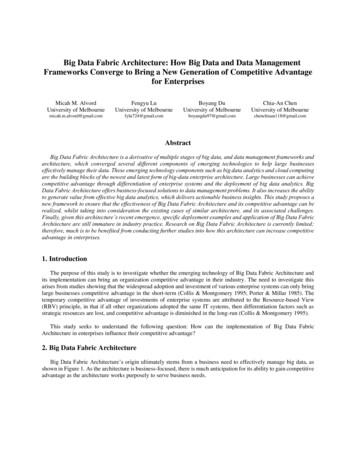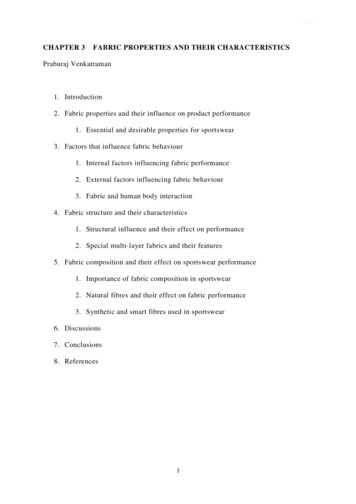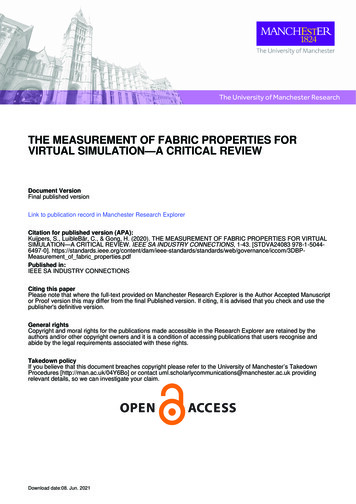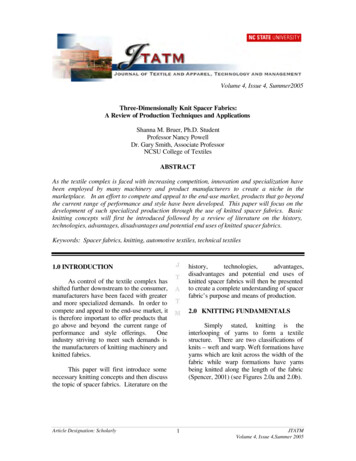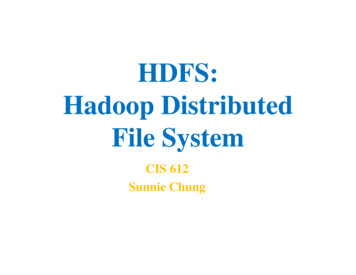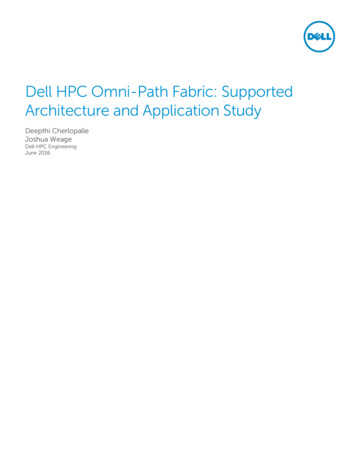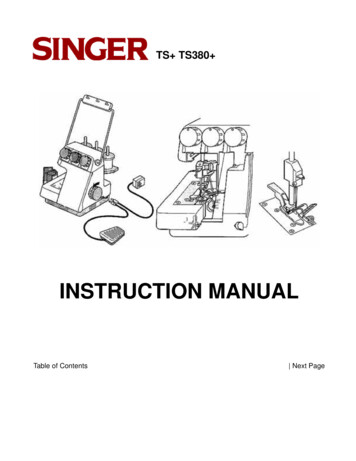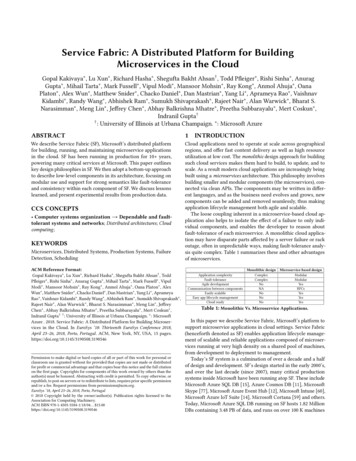
Transcription
Service Fabric: A Distributed Platform for BuildingMicroservices in the CloudGopal Kakivaya , Lu Xun , Richard Hasha , Shegufta Bakht Ahsan† , Todd Pfleiger , Rishi Sinha , AnuragGupta , Mihail Tarta , Mark Fussell , Vipul Modi , Mansoor Mohsin , Ray Kong , Anmol Ahuja , OanaPlaton , Alex Wun , Matthew Snider , Chacko Daniel , Dan Mastrian , Yang Li , Aprameya Rao , VaishnavKidambi , Randy Wang , Abhishek Ram , Sumukh Shivaprakash , Rajeet Nair , Alan Warwick , Bharat S.Narasimman , Meng Lin , Jeffrey Chen , Abhay Balkrishna Mhatre , Preetha Subbarayalu , Mert Coskun ,Indranil Gupta†† : University of Illinois at Urbana Champaign. : Microsoft AzureABSTRACT1We describe Service Fabric (SF), Microsoft’s distributed platformfor building, running, and maintaining microservice applicationsin the cloud. SF has been running in production for 10 years,powering many critical services at Microsoft. This paper outlineskey design philosophies in SF. We then adopt a bottom-up approachto describe low-level components in its architecture, focusing onmodular use and support for strong semantics like fault-toleranceand consistency within each component of SF. We discuss lessonslearned, and present experimental results from production data.Cloud applications need to operate at scale across geographicalregions, and offer fast content delivery as well as high resourceutilization at low cost. The monolithic design approach for buildingsuch cloud services makes them hard to build, to update, and toscale. As a result modern cloud applications are increasingly beingbuilt using a microservices architecture. This philosophy involvesbuilding smaller and modular components (the microservices), connected via clean APIs. The components may be written in different languages, and as the business need evolves and grows, newcomponents can be added and removed seamlessly, thus makingapplication lifecycle management both agile and scalable.The loose coupling inherent in a microservice-based cloud application also helps to isolate the effect of a failure to only individual components, and enables the developer to reason aboutfault-tolerance of each microservice. A monolithic cloud application may have disparate parts affected by a server failure or rackoutage, often in unpredictable ways, making fault-tolerance analysis quite complex. Table 1 summarizes these and other advantagesof microservices.CCS CONCEPTS Computer systems organization Dependable and faulttolerant systems and networks; Distributed architectures; Cloudcomputing;KEYWORDSMicroservices, Distributed Systems, Production Systems, FailureDetection, SchedulingINTRODUCTIONMonolithic design Microservice-based designACM Reference Format:Application complexityComplexModularGopal Kakivaya , Lu Xun , Richard Hasha , Shegufta Bakht Ahsan† , ToddFault-toleranceComplexModularPfleiger , Rishi Sinha , Anurag Gupta , Mihail Tarta , Mark Fussell , VipulAgile developmentNoYesModi , Mansoor Mohsin , Ray Kong , Anmol Ahuja , Oana Platon , AlexCommunication between componentsNARPCs Easily scalableNoYesWun , Matthew Snider , Chacko Daniel , Dan Mastrian , Yang Li , AprameyaEasy app lifecycle managementNoYesRao , Vaishnav Kidambi , Randy Wang , Abhishek Ram , Sumukh Shivaprakash ,Cloud readyNoYesRajeet Nair , Alan Warwick , Bharat S. Narasimman , Meng Lin , JeffreyTable 1: Monolithic Vs. Microservice Applications.Chen , Abhay Balkrishna Mhatre , Preetha Subbarayalu , Mert Coskun ,Indranil Gupta† † : University of Illinois at Urbana Champaign. : MicrosoftIn this paper we describe Service Fabric, Microsoft’s platform toAzure . 2018. Service Fabric: A Distributed Platform for Building Microsersupport microservice applications in cloud settings. Service Fabricvices in the Cloud. In EuroSys ’18: Thirteenth EuroSys Conference 2018,April 23–26, 2018, Porto, Portugal. ACM, New York, NY, USA, 15 pages.(henceforth denoted as SF) enables application lifecycle managehttps://doi.org/10.1145/3190508.3190546ment of scalable and reliable applications composed of microser-Permission to make digital or hard copies of all or part of this work for personal orclassroom use is granted without fee provided that copies are not made or distributedfor profit or commercial advantage and that copies bear this notice and the full citationon the first page. Copyrights for components of this work owned by others than theauthor(s) must be honored. Abstracting with credit is permitted. To copy otherwise, orrepublish, to post on servers or to redistribute to lists, requires prior specific permissionand/or a fee. Request permissions from permissions@acm.org.EuroSys ’18, April 23–26, 2018, Porto, Portugal 2018 Copyright held by the owner/author(s). Publication rights licensed to theAssociation for Computing Machinery.ACM ISBN 978-1-4503-5584-1/18/04. . . 15.00https://doi.org/10.1145/3190508.3190546vices running at very high density on a shared pool of machines,from development to deployment to management.Today’s SF system is a culmination of over a decade and a halfof design and development. SF’s design started in the early 2000’s,and over the last decade (since 2007), many critical productionsystems inside Microsoft have been running atop SF. These includeMicrosoft Azure SQL DB [15], Azure Cosmos DB [11], MicrosoftSkype [77], Microsoft Azure Event Hub [12], Microsoft Intune [60],Microsoft Azure IoT Suite [14], Microsoft Cortana [59] and others.Today, Microsoft Azure SQL DB running on SF hosts 1.82 MillionDBs containing 3.48 PB of data, and runs on over 100 K machines
EuroSys ’18, April 23–26, 2018, Porto, Portugalacross multiple geo-distributed datacenters. Azure Cosmos DB runson over 2 million cores and 100 K machines. The cloud telemetryengine on SF processes 3 Trillion events/week. Overall, SF runs 24 7in multiple clusters (each with 100s to many 1000s of machines),totaling over 160 K machines with over 2.5 Million cores.Driven by our production use cases, the architecture of SF followsfive major design principles:Kakivaya et al.2MICROSERVICE APPROACHThe concepts underlying microservices have been around for manyyears, from object-oriented languages, to Service Oriented Architectures (SOA). Many companies (besides Microsoft), rely ona microservice-based approach. Netflix has used a fine-grainedSOA [85] for a long time to withstand nearly two billion edge APIrequests per day [82]. Modular and Layered Design of its individual components,with clean APIs. Self-* Properties including self-healing and self-adjusting properties to enable automated failure recovery, scale out, and scalein. Self-sufficiency, meaning no external dependencies on external systems or storage. Fully decentralized operation avoids single points of contention and failure, and accommodates microservice applications from small groups to very large groups of VMs/containers. Strong Consistency both within and across components, toprevent cascades of inconsistency. Support for Stateful Services such as higher-level data-structures(e.g., dictionaries, queues) that are reliable, persistent, efficient,and transactional.Service Fabric is the only microservice system that meets all theabove principles. Existing systems provide varying levels of supportfor microservices, the most prominent being Nirmata [64], Akka [3],Bluemix [21], Kubernetes [51], Mesos [44], and AWS Lambda [7].SF is more powerful: it is the only data-aware orchestration systemtoday for stateful microservices. In particular, our need to supportstate and consistency in low-level architectural components drivesus to solve hard distributed computing problems related to failuredetection, failover, election, consistency, scalability, and manageability. Unlike these systems, SF has no external dependencies andis a standalone framework. Section 9 expands on further differencesbetween SF and related systems.Service Fabric was built over 16 years, by many (over 100 core)engineers. It is a vast system containing several interconnected andintegrated subsystems. It is infeasible to compress this effort intoone paper. Therefore, instead of a top-down architectural story, thispaper performs a deep dive on selected critical subsystems of SF,illustrating via a bottom-up strategy how our principles drove thedesign of key low-level building blocks in SF.The contributions of this paper include: We describe design goals, and SF components that: detect failures, route virtually among nodes, elect leaders, perform failover,balance load, and manage replicas. We touch on higher-level abstractions for stateful services (Reliable Collections). We discuss lessons learnt over 10 years. We present experimental results from real datasets that wecollected from SF production clusters.It is common in industry to integrate disparate systems into awhole. We believe there is a desperate need in the systems community for a paper that reveals insight into how different subsystemscan be successfully built and integrated under cohesive design principles.Figure 1: A Microservice-based Application. a) Each colored/tiledhexagon type represents a microservice, and b) Its instances can be deployedflexibly across VMs.SF provides first-class support for full Application Lifecycle Management (ALM) of cloud applications, from development, deployment, daily management, to eventual decommissioning. It providessystem services to deploy, upgrade, detect, and restart failed services; discover service location; manage state; and monitor health.SF clusters are today created in a variety of environments, in privateand public clouds, and on Linux and Windows Server containers.If such microservices were small in number, it may be possibleto have a small team of developers managing them. In productionenvironments, however, there are hundreds of thousands of suchmicroservices running in an unpredictable cloud environment [17,18, 35, 36, 87]. SF is an automated system that provides support forthe complex task of managing these microservices.Building cloud applications atop SF (via microservices) affordsseveral advantages:(1) Modular Design and Development: By isolating the functionality and via clean APIs, services have well-defined inputs and outputs, which make unit testing, load testing, andintegration testing easier.(2) Agility: Individual teams that own services can independently build, deploy, test, and manage them based on theteam’s expertise or what is most appropriate for the problem to be solved. This makes the development process moreagile and lends itself to assigning each microservice to smallnimble teams.SF provides rolling upgrades, granular versioning, packaging, and deployment to achieve faster delivery cycles, andmaintain up-time during upgrades. Build and deploymentautomation along with fault injection allows for continuousintegration and deployment.(3) Scalability: A monolithic application can be scaled onlyby deploying the entire application logic on new nodes(VMs/containers). As Fig. 1 shows, in SF only individual
Service Fabric: A Distributed Platform for Building Microservices in the Cloudmicroservices that need to scale can be added to new nodes,without impacting other services.This approach allows an application to scale as the numberof users, devices and content grows, by scaling the cluster ondemand. Incremental deployment is done in a controlled way:one at a time, or in groups, or all at once, depending on thedeployment stage (integration testing, canary deployments,and production deployments).(4) Resource Management: SF manages multiple applicationsrunning on shared nodes, scaling themselves continuously,because the workloads change dynamically all the time. Thecomponents of SF that this paper fleshes out help keep nodes’load balanced, route messages efficiently, detect failuresquickly and without confusion, and react to failures quicklyand transparently.(5) Support for State: SF provides useful abstractions for stateful services, namely Reliable Collections, a data-structurethat is distributed, fault-tolerant, and scalable.2.1Microservice Application Model in ServiceFabricFigure 2: Service Fabric Application Model. An application consists ofN services, each of them with their own Code, Config. and Data.In Service Fabric, an application is a collection of constituent microservices (stateful or stateless), each of which performs a completeand standalone function and is composed of code, configuration anddata. This is depicted in Fig. 2. The code consists of the executablebinaries, the configurations consist of service settings that can beloaded at run time, and the data consists of arbitrary static datato be consumed by the microservice. A powerful feature of SF isthat each component in the hierarchical application model can beversioned and upgraded independently.2.2Service Fabric and Its GoalsAs mentioned earlier, Service Fabric (SF) provides first-class supportfor full Application Lifecycle Management (ALM) of microservicebased cloud applications, from development to deployment, dailymanagement, and eventual decommissioning. The two most uniquegoals of SF are:i) Support for Strong Consistency: A guiding principle is thatSF’s components must each offer strong consistency behaviors.Consistency means different things in different contexts: strongconsistent failure detection in the membership module vs. ACID inReliable Collections.We considered two prevalent philosophies for building consistentapplications: build them atop inconsistent components [2, 88, 89],or use consistent components from the ground up. The end to endEuroSys ’18, April 23–26, 2018, Porto, Portugalprinciple [76] dictates that if the performance is worth the costfor a functionality then it can be built into the middle. Based onour use case studies we found that a majority of teams needing SFhad strong consistency requirements, e.g., Microsoft Azure SQLDB, Microsoft Business Analytics Tools etc., all rely on SF whileexecuting transactions. If consistency were instead to only be builtat the application layer, each distinct application will have to hiredistributed systems developers, spend development resources, andtake longer to reach production quality.Supporting consistency at each layer: a) allows higher layer design to focus on their relevant notion of consistency (e.g., ACIDat Reliable Collections layer), and b) allows both weakly consistent applications (key-value stores such as Azure Cosmos DB) andstrongly consistent applications (DBs) to be built atop SF–this iseasier than building consistent applications over an inconsistentsubstrate. With clear responsibilities in each component, we havefound it easier to diagnose livesite issues (e.g., outages) by zeroingin on the component that is misbehaving, and isolating failures androot causes between platform and application layers.ii) Support for Stateful Microservices: Besides the statelessmicroservices (e.g., protocol gateways, web proxies, etc.), SF supports stateful microservices that maintain a mutable, authoritativestate beyond the service request and its response, e.g., for user accounts, databases, shopping carts etc. Two reasons to have statefulmicroservices along with stateless ones are: a) The ability to buildhigh-throughput, low-latency, failure-tolerant online transactionprocessing (OLTP) services by keeping code and data close on thesame machine, and b) To simplify the application design by removing the need for additional queues and caches. For instance, SF’sstateful microservices are used by Microsoft Skype to maintain important state such as address books, chat history, etc. In SF statefulservices are implemented via Reliable Collections.2.3Use Cases: Real SF ApplicationsSince Service Fabric was made public in 2015 several external userorganizations have built applications atop it. In order to illustratehow global-scale applications can be built using microservices, webriefly describe four of these use cases. Our use cases show: a) howreal microservice applications can be built using SF; b) how themicroservice approach was preferable to users than the monolithicapproach; and c) how SF support for state and consistency (inparticular Reliable Collections) are invaluable to developers. (Thissection can be skipped by the reader without loss in continuity.)Tutorials are available to readers interested in learning how-tobuild microservice applications over Service Fabric–please see [62].I. BMW is one of the largest luxury car companies in the world.Their in-vehicle app BMW Connected [22] is a personal mobilitycompanion that learns a user’s mobility patterns by combiningmachine-learned driver intents, real-time telemetry from devices,and up-to-date commute conditions such as traffic. This app relies on a cloud service that was built using SF and today runs onMicrosoft Azure, supporting 6 million vehicles worldwide.The SF application is called BMW’s Open Mobility Cloud (OMC) [23,29]. It needs to be continually updated with learned behaviors andfrom traffic commute update streams. OMC consists of several major subsystems. Among them, we will focus on the core component
EuroSys ’18, April 23–26, 2018, Porto, PortugalKakivaya et al.Figure 3: Major Subsystems of Service Fabric. NS Naming Service, PLB Placement and Load Balancer.called the Context and Profile Subsystem (C&P). C&P consists offive key SF microservices:SQL DB, they implemented an SQL broker that periodically cachesthe most heavily-accessed metadata tables.i) Context API Stateless Service: Non-SF components communicate with the C&P via this service, e.g., mobile clients cancreate/change locations and trips.ii) Driver Actor Stateful Service: This per-driver stateful service tracks the driver’s profile, and generates notifications suchas trip start times. It receives data from five sources: syncmessages from the Context API service, a stream of current locations of the driver (from Location Consumer service), learneddestinations and predicted trips (from MySense machine learning service), deleted anonymous user IDs (from User Deleteservice), and trip time estimates (from ETA Queue service).iii) Location Consumer Stateless Service: Each mobile clientsends a stream of geo-locations to the Microsoft Azure EventHub, pulled by the Location Consumer service and fed to theappropriate driver actor.iv) Commute Service: The Commute service takes geo-locationand trip start and end points, and then communicates with anexternal service to generate drive time.v) ETA Queue Stateful Service: This decouples driver actorsfrom the Commute server and allows asynchronous communication between the two services.III. Quorum Business Solutions [68, 69] is a SCADA companythat collects and manages data from field-operations platforms ontens of thousands of wells across North America. Their implementation on SF uses actors that reliably collect and process data becausethey are stateful, a stateless gateway service for auto-scalability,and a stateful batch aggregator service that monitors actors themselves. They implement interactions with third parties (SQL DB,Redis) via notification and retry microservices in SF.IV. TalkTalk TV [31, 81] is one of the largest cable TV providersin United Kingdom. It delivers the latest TV and movie content to amillion monthly users, via a variety of devices and smart TVs. TheirSF application is used to encode movie streams before deliveryto the customer, and uses stateful services, structured in a linearsequence: record encoding requests, initiate encoding processes,and track these processes. A stateless gateway interacts with clients.3SERVICE FABRIC: KEY COMPONENTSThe use of SF makes BMW’s C&P Subsystem highly-available,fault-tolerant, agile, and scalable. For instance, when the number ofactive vehicles increases, the Context API service and Driver actorservices are scaled out in size. When the number of moving vehicleschanges, the Location Consumer and ETA Queue stateful servicescan be scaled in size. The remaining services remain untouched. SFhelps to optimize resource usage so that incurred dollar costs ofusing Microsoft Azure are minimized.II. Mesh Systems [30, 58] is an 11-year old company that providesIoT software and services for enterprise IoT customers. They startedout with a monolithic application that was too complex, and wereunable to accommodate the needs of their growing business. Thisprevious system also underutilized their cluster.Mesh Systems’s SF application achieves high resource utilization,and scalability by leveraging Reliable Collections. One of their needswas to scale out the payload processing independent of notifications,and it was a good match with SF’s ability to scale out individualmicroservices. Their SF application also leverages local state toimprove performance, e.g., to minimize the load on Microsoft AzureFigure 4: Federation and Reliability Subsystems: Deep-Dive.Service Fabric (SF) is composed of multiple subsystems, relyingon each other modularly via clean APIs and protocols. Fig. 3 depictshow they are stacked–upper subsystem layers leverage lower layers.Given space constraints, this paper largely focuses on SF’s mostunique components, shown in Fig. 4. These lie in two subsystems:Federation and Reliability.
Service Fabric: A Distributed Platform for Building Microservices in the CloudThe Federation Subsystem (Sec. 4) forms the heart of SF. It solvescritical distributed systems problems like failure detection, a consistent ring with routing, and leader election. The Transport Subsystemunderneath provides secure node-to-node communication.Built atop the Federation Subsystem is the Reliability Subsystem(Sec. 5), which provides replication and high availability. Its components are the Failover Manager (FM), Failover Manager Master(FMM), the Placement and Load Balancer (PLB), and replicationprotocols. This helps create distributed abstractions named ReliableCollections (Sec. 6).Other SF subsystems not detailed in this paper include the Management Subsystem which provides full application and clusterlifecycle management via the Cluster Manager, Health Manager,and Image Store. The Communication Subsystem allows reliableservice discovery via the Naming Service. The Testability Subsystem contains a Fault Injection Service. Hosting and ActivationSubsystems manage other parts of the application lifecycle.4FEDERATION SUBSYSTEMWe describe SF’s ring, failure detection, consistent routing, andleader election.4.1Basic SF-RingNodes in SF are organized in a virtual ring, which we call SF-Ring.This consists of a virtual ring with 2m points (e.g., m 128 bits).Nodes and keys are mapped on to a point in the ring. A key is ownedby the node closest to it, with ties won by the predecessor. Eachnode keeps track of multiple (a given number of) its immediatesuccessor nodes and predecessor nodes in the ring–we call this theneighborhood set. Neighbors are used to run SF’s membership andfailure detection protocol, which we describe next.Nodes also maintain long-distance routing partners. Section 4.3will later outline these and consistent routing.4.2Consistent Membership and FailureDetectionMembership and failure detection in SF relies on two key designprinciples: Strongly Consistent Membership: All nodes responsible formonitoring a node X must agree on whether X is up or down.When used in the SF-Ring, this entails a consistent neighborhood,i.e., all successors/predecessors in the neighborhood of a nodeX agree on X’s status. Decoupling Failure Detection from Failure Decision: Failure detection protocols can lead to conflicting detections. Tomitigate this, we decouple the decision of which nodes are failedfrom the detection itself.4.2.1 Lease-based Heartbeating. We first describe our heartbeating protocol in general terms, and then how it is used in SF-Ring.Monitors and Leases: Heartbeating is fully decentralized. Eachnode X is monitored by a subset of other nodes, which we call itsmonitors. Node X periodically sends a lease renewal request (LR,heartbeat message with unique sequence number) to each of itsmonitors. When a monitor acknowledges (LR ack ), node X is said toEuroSys ’18, April 23–26, 2018, Porto, Portugalobtain a lease, and the monitor guarantees not to detect X as failedfor the leasing period. The leasing period, labeled Tm , is adjustedadaptively based on round trip time and some laxity, but a typicalvalue is 30 s. To remain healthy, node X must obtain acks (leases)from all of its monitors. This defines strong consistency. If nodeX fails to renew any of its leases from its monitors, it considersremoving itself from the group. If a monitor misses a heartbeat fromX, it considers marking X as failed. In both these cases however,the final decision needs to be confirmed by the arbitrator group(described in Sec. 4.2.2).Lease renewal is critical, but packet drops may cause it to fail.To mitigate this, if node X does not receive LR ack within a timeout(based on RTT), it re-sends the lease message LR until it receivesLR ack . Resends are iterative.Symmetric Monitoring in SF-Ring: The monitors of a node areits neighborhood (successors and predecessors in the ring). Neighborhood monitoring relationships are purely symmetric. When twonodes X and Y are monitoring each other, their lease protocols arerun largely independently, with a few exceptions. First, if X failsto renew its own lease within the timeout, it denies any furtherlease requests from Y (since X will leave the group soon anyway).Second, if X detects Y as having failed, X stops sending lease renewrequests to Y. Such cases have the potential to create inconsistencies, however our use of the arbitrator group (which we describenext) keeps the membership lists consistent.4.2.2 Using the Arbitrator Group to Decouple Detectionfrom Decision. Decoupling Failure Detection from Decision:Decentralized failure detection techniques carry many subtletiesinvolving timeouts, indirection, pinging, etc. Protocols exist thatgive eventual liveness properties (e.g., [32, 83]), but in order to scale,they allow inconsistent membership lists. However, our need is tomaintain a strongly consistent neighborhood in the ring, and alsoreach decisions quickly.To accomplish these goals, we decouple decisions on failuresfrom the act of detection. Failure detection is fully decentralizedusing Sec. 4.2.1’s lease-based heartbeating. For decisions, we use alightweight arbitrator. The arbitrator does not help in detecting failures (as this would increase load), but only in affirming or denyingdecisions.Arbitrator: The arbitrator acts as a referee for failure detections,and for detection conflicts. For speed and fault-tolerance, the arbitrator is implemented as a decentralized group of nodes thatoperate independent of each other. When any node in the systemdetects a failure, before taking actions relevant to the failure, itneeds to obtain confirmation from a majority (quorum) of nodes inthe arbitrator group.Failure reporting to/from an arbitrator node works as follows.Suppose a node X detects Y as having failed. X sends a fail(Y)message to the arbitrator. If the arbitrator already marked X asfailed, the fail(Y) message is ignored, and X is again asked to leavethe group. Otherwise, if this is the first failure report for Y, it isadded to a recently-failed list at the arbitrator. An accept(fail(Y))message is sent back to X within a timeout based on RTT (if thistimeout elapses, X itself leaves the ring). The accept message also
EuroSys ’18, April 23–26, 2018, Porto, PortugalKakivaya et al.carries a timer value called To , so that X can wait for To time andthen take actions w.r.t. Y (e.g., reclaim Y’s portion of the ring).When Y next attempts to renew its lease with X (this occurswithin Tm time units after X detects it), X either denies it or doesnot respond. Y sends a fail(X) message to the arbitrator. Since Y isalready present in the recently-failed list at the arbitrator, Y is askedto leave the group. (If this exchange fails, Y will leave anyway as itfailed to renew its lease with X.) If on the other hand, Y’s lease renewal failed because X was truly failed, then the arbitrator sends anaccept(fail(X)) message to Y. We set: To Tm laxity - (time sincefirst detection). If this is the first detection, To Tm laxity. Here,laxity is typically 30 s, generously accounts for network latenciesinvolved in arbitrator coordination, and independent of Tm . As alltimeouts are large (tens of seconds), loose time synchronizationsuffices.Vs. Related Work: SF’s leases are comparable to heartbeat-stylefailure detection algorithms from the past (e.g., [83]). The novel ideain SF is to use lightweight arbitrator groups to ensure membershipstays consistent (in the ring neighborhood). This allows the membership, and hence the ring, to scale to whole datacenters. Withoutthe arbitrators, distributed membership will have inconsistencies(e.g., gossip, SWIM/Serf [32]), or one needs a heavyweight centralgroup (e.g., Zookeeper [45], Chubby [24]) which has its own issues.Stronger consistent membership like virtual synchrony [19, 20] donot scale to datacenters.In SF-Ring: Inside SF-Ring, failure detections occur in the neighborhood, to maintain a consistent neighborhood. If node X suspectsa neighbor (Y), it sends a fail(Y) to the arbitrator, but waits for Totime after receiving the accept(.) message before reclaiming theportion of Y’s ring. Any routing requests (Section 4.3) receivedmeanwhile for Y will be queued, but processed only after the rangehas been inherited by Y’s neighbors.We describe the full SF-Ring, expanding on the basic design fromSection 4.1. SF-Ring is a distributed hash table (DHT). It provides aseamless way of scaling from small groups to large groups. SF-Ringwas developed internally [42, 43, 47, 48] in Microsoft, in the early2000s, concurrent with the emergence of P2P DHTs like Pastry,Chord [75, 79], and others [39, 40, 57, 70]. We descr
utilization at low cost. The monolithic design approach for building such cloud services makes them hard to build, to update, and to scale. As a result modern cloud applications are increasingly being built using a microservices architecture. This philosophy involves building smaller and modular components (the microservices), con-nected via .
